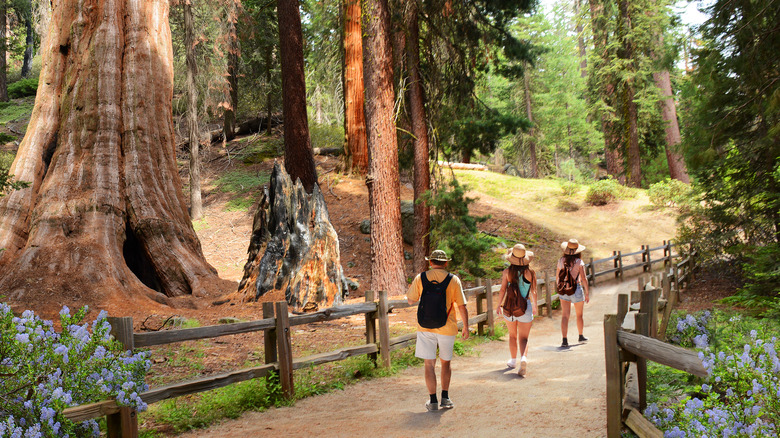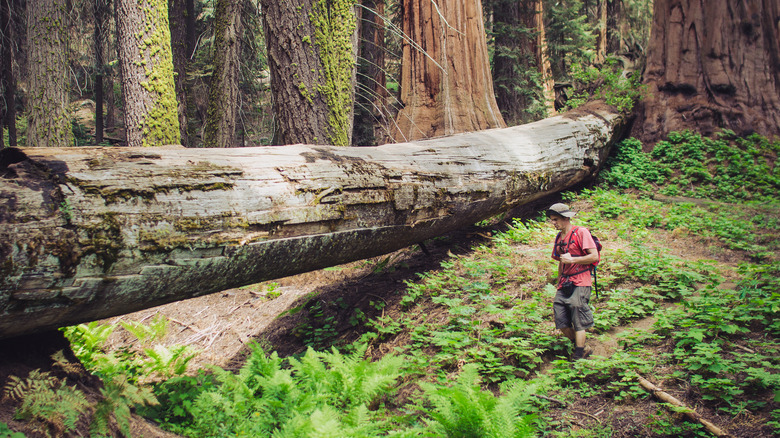The Real Meaning Of California's Sequoia And Kings Canyon National Parks' 'No Shortcuts' Rule
California's national parks are home to trees that predate the Roman Empire and canyons that are the remnants of glacier movements millennia ago. Therefore, it's understandable why there are strict rules in place to protect these sacred spaces. Sequoia & Kings Canyon National Parks are popular California visiting sites — just be mindful of their policies on protection and preservation.
Located between Los Angeles and San Francisco, and just 53 miles from the city of Fresno, Sequoia National Park and Kings Canyon National Park are often referred to as one park, but are actually two separate parks. Both areas border each other, and a visitor's pass at one location can get you access to the other. Sequoia National Park rewards hikers with giant sequoia trees — some of the tallest in the world, such as the General Sherman Tree, the largest on Earth by volume. Kings Canyon National Park, on the other hand, offers visitors views of majestic canyons and picturesque valleys.
But amid the scenic beauty and natural wonder of these parks, visitors may be surprised to encounter an unusual but firm rule: no shortcuts. While it may sound oddly specific, the "no shortcuts" mandate has a critical purpose, as ignoring it could damage the very landscapes that make these parks so spectacular. The enforced rule applies primarily to hikers who venture off designated trails to take a faster route or to explore the fairytale-like terrain. But these ventures have environmental consequences. Repeated foot traffic over unofficial paths can destroy vegetation and cause erosion. Violating this rule is a breach of wilderness protection laws and can result in legal action.
What other rules does Sequoia National Park and Kings Canyon National Park enforce?
Exploring California's impressive tree culture is certainly something to add to your bucket list. From the wildly enchanting groves of Grizzly Creek Redwoods State Park and the otherworldly Redwood National Park with the world's tallest trees — both of which are north of San Francisco — to the Ancient Bristlecone Pine Forest that boasts the world's oldest trees, the Golden State's natural history is a sight to behold. But before visiting these wonders, make sure to take heed of the park's rules and regulations.
To avoid penalties and disturbing the terrain at Sequoia National Park and Kings Canyon National Park, stay on the well-marked alpine trails specifically designed to reduce erosion and make steep trails safer. The footpaths have been described online by visitors as fairly moderate with some hills, while Kings Canyon National Park offers longer trails than Sequoia National Park — something to keep in mind if you want to avoid a longer, more tiring hike. Both parks are also accessible for people who use wheelchairs, and shuttle buses are available for folks with mobility impairments.
As well as the "no shortcuts" rule, both destinations enforce the United States Title 36 of the Code of Federal Regulations, which protects park resources. Some important rules visitors should know relate to staying overnight, such as no camping near water that's under 25 feet away, and the practice of proper food storage to prevent encounters with bears. Rock cairns are also prohibited, as well as pets, and a maximum of 15 people in a group are allowed on the trails together. For more information, visit the Sequoia and Kings Canyon National Parks Minimum Impact Restrictions.

